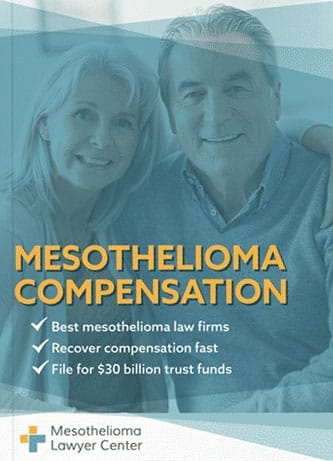The fallen World Trade Center towers released clouds of toxic dust on 9/11, including asbestos, a mineral that causes mesothelioma, lung cancer, and other illnesses. The tragedy of 9/11 left some first responders and others with debilitating diseases, like mesothelioma, lung cancer, and others.
If you or a loved one received a diagnosis of mesothelioma, asbestos-related lung cancer, or asbestosis, you might be entitled to substantial compensation. Fill out our form to receive our free Financial Compensation Packet. Our packet is loaded with information on experienced mesothelioma attorneys in your area, how to file a claim for asbestos trust funds, how to get paid in 90 days, and more.


FREE Financial Compensation Packet
- Info on law firms that will recover your HIGHEST COMPENSATION
- Learn how to get paid in 90 days
- File for your share of $30 billion in trust funds
Asbestos at Ground Zero
On September 11, 2001, tragedy struck the United States when terrorists flew two hijacked airplanes into the World Trade Center (WTC), killing over 2,000 people and injuring many more.
The area of devastation left by the incident became known as Ground Zero. It was contaminated with all the debris of the buildings. This included many harmful toxins, like asbestos.
What Was in World Trade Center Dust?
The debris and dust left after the disaster included everything contained in the Twin Towers before they fell. Some of the substances detected in the dust included:
- Glass
- Asbestos
- Cement
- Heavy metals
- Polychlorinated biphenyls (PCBs)
- Dioxin
- Gypsum
- Cellulose
In the week after the attacks, the U.S. Environmental Protection Agency found more than 1% asbestos in 25% of the samples it took at Ground Zero. Anything over 1% is considered a significant risk.
Why Was There Asbestos in the World Trade Center?
The World Trade Center was built in the 1960s and 1970s, a peak time for asbestos use in construction. Many construction materials contained asbestos to provide strength and heat and fire resistance. Estimates suggest there were between 300 and 400 tons of asbestos materials in the north tower.
Many of the steel beams in the north tower were sprayed with asbestos foam, for instance. This provided fireproofing. As construction continued on the towers, asbestos use was largely discontinued. However, many components with asbestos had already gone into the buildings.
Health Effects of Exposure to 9/11 Debris and Dust
In the aftermath, thousands of people and approximately 400 dogs helped search for survivors and clean up the debris and waste after the disaster. Several groups of people were affected by the aftermath. It is estimated that nearly 500,000 people had some exposure to the toxic World Trade Center dust.
First Responders
Around 4,000 police officers, firefighters, and EMT professionals provided invaluable help during and after the 9/11 tragedy. The main focus of these professionals was to save as many lives as possible. As a result, first responders didn’t necessarily have time to ensure they had the proper protective gear.
After the attacks, firefighters worked tirelessly among toxins permeating the air, trying to extinguish fires. Others had to work in dangerous materials, breathing in asbestos and other toxins.
According to a study published in 2011, firefighters who responded to the World Trade Center site are 19% more likely to develop cancer than the general population. The increased risk is due to the inhalation of asbestos and other toxins.
Cleanup Crews
Cleanup crews worked extremely long hours for many months, trying to clear out the debris in the aftermath of 9/11. Many of the cleanup crews consisted of truck drivers who would load waste and unload it at disposal sites.
Many of the cleanup workers didn’t wear the proper protection, nor did most understand the type of toxins they were being exposed to while cleaning up the site.
Local Residents and Workers
Anyone near the 9/11 incident, including workers, children at school, and even residents in nearby areas, risked inhaling asbestos fibers and other toxic materials in the air.
When interviewed after the attacks, numerous residents in the area described the air as a gray and white-colored dust that eventually settled onto their homes.
At the time, the Environmental Protection Agency (EPA) assured people that the air was safe. Yet, when independent companies tested the air quality, the results indicated that the air was extremely dangerous.
In some places, the amount of asbestos in the air was 20 times the standardized threshold.
Others that are at a heightened risk of developing an asbestos-related illness after helping during 9/11 include:
- Engineers
- Carpenters
- Masons
- American Red Cross volunteers
- Truckers
- Steelworkers
- Additional volunteers
Asbestos materials were blown to dust and permeated throughout the area. It not only affected rescue and cleanup workers but also anyone within the vicinity.
Regardless of job title and rescue effort, every person was at risk of developing mesothelioma and other asbestos-related illnesses.
According to The World Trade Center Health Registry, over 400,000 people were exposed to harmful toxins in the aftermath of 9/11. Rescue workers, in particular, are at the highest risk of developing mesothelioma and other dangerous diseases, as they were the first people on the scene and the last to leave.
Asbestos Exposure and Health Issues After 9/11
According to the U.S. Environmental Protection Agency (EPA), 20 stories worth of asbestos-containing products “pulverized asbestos to ultra-fine particles,” which then spread all across Manhattan.
Asbestos exposure causes several life-threatening illnesses, including malignant mesothelioma, asbestosis, and asbestos-related lung cancer.
Many people affected by asbestos exposure during 9/11 may not even know they’ve developed an asbestos-related illness yet.
In many cases, asbestos illnesses can take anywhere from 20 to 50 years before the first symptoms surface, although sometimes the deadly disease presents itself much sooner.
How Many People Have Died From Toxic 9/11 Dust?
According to a 2015 report published by USA Today, over 1,700 people have already passed away from illnesses connected to the aftermath of 9/11. More recent reports will almost certainly include more deaths related to the attacks.
Study Says People Are Dying Earlier Than Average
Mesothelioma is one of the many illnesses found during a study performed by The World Trade Center Health. The study also indicated that some people died much sooner than is typical with asbestos exposure and mesothelioma.
For example, the National EMS Memorial Service reported that 42-year-old Deborah Reeve lost her battle with mesothelioma in 2004, only three years after being exposed to asbestos while working with a rescue crew.
Experts Say More People Will Develop an Asbestos Disease
Experts predict more people involved in Ground Zero will develop an asbestos-related disease in the future. Advocates for those affected during the 9/11 rescue and cleanup efforts urge lawmakers to extend the James Zadroga 9/11 Health and Compensation Act, which expired on September 30, 2015.
In April 2019, the Daily Toreador reported that “as of 2018, more than 10,000” people involved in Ground Zero have been diagnosed with cancer and illnesses connected to the incident.
Other Cancers and Illnesses Associated with 9/11 Exposure
Mesothelioma is specifically related to asbestos exposure. Asbestos can also contribute to other cancers. The other toxins in the 9/11 dust are also linked with numerous other types of cancer. Anyone exposed to the dust could be at an increased risk for:
- Leukemia
- Lung cancer
- Lymphoma
- Mesothelioma
- Myeloma
- Oropharyngeal cancers
- Prostate cancer
- Thyroid cancer
Non-cancerous illnesses associated with 9/11 exposures include:
- Asbestosis
- Cardiovascular disease
- Chronic respiratory disease
- Depression
- Early-onset dementia
- Gastroesophageal reflux disease (GERD)
- Hearing loss
- Obstructive sleep apnea
- Post-traumatic stress disorder
- Pulmonary fibrosis
- Sarcoidosis
Low Birth Weights After 9/11
Even young people not born before September 11 have been affected by the incident. Since the 9/11 tragedy, New York has recorded more infants born with low birth weight than usual.
Although it’s still unknown whether 9/11 is the cause of the low birth rates, numerous studies theorize women who inhaled the toxins during 9/11 may have led to having a baby with low birth weight.
Could I Be at Risk for Asbestos Illness After 9/11?
Anyone involved in the first response and cleanup of the World Trade Center site could be at risk for related illnesses. But other people are at risk too. If you were in the area that day, you could have been exposed to harmful toxins.
The 9/11 Treatment Referral Program provides free treatment to survivors of the tragedy with a related illness. It defines survivors as anyone within a 1.5-mile radius of the World Trade Center.
This includes people who were present on the day of the incident. It also includes people within the survivor radius later, who attended school, worked there, or provided support, and now have an illness connected to the site.
What Should I Do if I Was Exposed to 9/11 Asbestos Dust?
If you were in the area all those years ago, you could still be at risk for illness. Asbestos diseases, like mesothelioma, often only develop decades after exposure. If you are concerned about your exposure to the 9/11 dust, you should:
- Try to recall when and where you were in the area and for how long
- Talk to your doctor about the risks
- Ask your doctor about any health screenings you should have
- Note any symptoms you have that could be relevant
- Notify your doctor as soon as you have any symptoms and get regular checkups
Resources for 9/11 Survivors
Whether you were a first responder or a bystander during the 9/11 attacks in New York City, you could be entitled to healthcare or compensation.
The World Trade Center Health Program
The World Trade Center Health Program provides benefits counseling, health monitoring, treatment, and mental health care for survivors. You can enroll as a member of one of the following groups:
- Fire Department of New York (FDNY) responders
- Other responders
- New York City survivors
- Pennsylvania and Pentagon responders
9/11 Victims Compensation Fund
Congress established the Victims Compensation Fund (VCF) in 2001 to provide victims with financial relief, but it closed in 2004.
In 2011, President Obama signed the Zadroga Act, which reactivated the VCF. It was to remain active for five years. It was extended through December 18, 2020, with funding increased to $7.375 billion.
President Trump signed The Never Forget the Heroes: James Zadroga, Ray Pfeifer, and Luis Alvarez Permanent Authorization of the September 11th Victim Compensation Fund in 2019.
The 2019 law extended the fund through 2090. It also authorized as much funds as needed to meet all eligible claims.
Additional Help and Resources for Asbestos Victims
Remember that you may qualify for significant compensation if you or a loved one have been diagnosed with mesothelioma, asbestos-related lung cancer, or asbestosis. Fill out our form to get your free Financial Compensation Packet, with information on experienced asbestos and mesothelioma lawyers in your area. If you need additional assistance or have any questions, feel free to contact us at 800-793-4540.

Paul Danziger
Reviewer and EditorPaul Danziger grew up in Houston, Texas and earned a law degree from Northwestern University School of Law in Chicago. For over 25 years years he has focused on representing mesothelioma cancer victims and others hurt by asbestos exposure. Paul and his law firm have represented thousands of people diagnosed with mesothelioma, asbestosis, and lung cancer, recovering significant compensation for injured clients. Every client is extremely important to Paul and he will take every call from clients who want to speak with him. Paul and his law firm handle mesothelioma cases throughout the United States.
References
- Tumulty, B.J. (2015, October 25). 9/11 Bill to Aid Ground Zero Workers Rapidly Gaining Support in Congress. USA Today.
Retrieved from: http://www.usatoday.com/story/news/politics/2015/10/25/911-bill-gaining-support-congress/74473474/ - McGuane, M. (2019, April 22). LETTER TO THE TEDITOR: “Never Forget” Applies to 9/11 Victims in Past, Continued Future. Daily Toreador.
Retrieved from: http://www.dailytoreador.com/opinion/letters_to_editor/letter-to-the-editor-never-forget-applies-to-victims-in/article_d54bacec-6559-11e9-b7e7-abd38aae37a5.html - Zeig-Owens, R., Webber, M.P., Hall, C.B., Schwartz, T., Jaber, N., Weakley, J., Rohan, T.E., Cohen, H.W., Derman, O., Aldrich, T.K., Kelly, K., and Prezant, D.J. (2011, September 3). Early Assessment of Cancer Outcomes in New York City Firefighters After the 9/11 Attacks: An Observational Cohort Study. Lancet. 378(9794), P898-905. DOI:https://doi.org/10.1016/S0140-6736(11)60989-6.
Retrieved from: https://www.thelancet.com/journals/lancet/article/PIIS0140-6736%2811%2960989-6/fulltext - City of New York. 9/11 Health. (n.d.). Your 9/11 Health Care.
Retrieved from: https://www.nyc.gov/site/911health/enrollees/9-11-treatment-referral-program.page - Lucchini, R. (2022, September 10). 9/11 Survivors’ Exposure to Toxic Dust and the Chronic Health Conditions that Followed Offer Lessons That Are Still Too Often Unheeded. The Conversation.
Retrieved from: https://theconversation.com/9-11-survivors-exposure-to-toxic-dust-and-the-chronic-health-conditions-that-followed-offer-lessons-that-are-still-too-often-unheeded-166537 - Biello, D. (2011, September 7). What Was in the World Trade Center Plume? Scientific American.
Retrieved from: https://www.scientificamerican.com/article/what-was-in-the-world-trade-center-plume/ - Centers for Disease Control and Prevention. (2023, July 24). 9.11 World Trade Center Health Program.
Retrieved from: https://www.cdc.gov/wtc/ - September 11th Victim Compensation Fund. (n.d.). About the Victim Compensation Fund.
Retrieved from: https://www.vcf.gov/about
